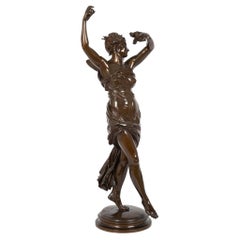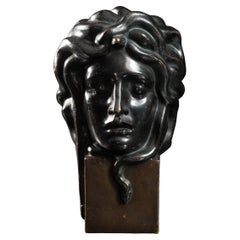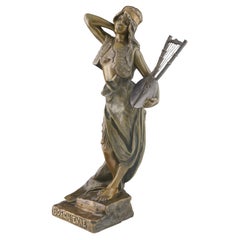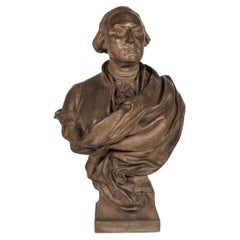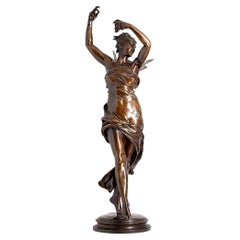Eugene Delaplanche Sculptures
Eugène Delaplanche was a French sculptor born in Belleville (Seine). He was a pupil of Francisque Joseph Duret. Delaplanche gained the Prix de Rome in 1864 (spending 1864-67 at the Villa Medici in Rome) and the medal of honor in 1878. His Messenger of Love (1874), Aurora (1878) and the Virgin of the Lillies (1884) are in Luxembourg. Other works by him are Music (1878, Paris Opera House), called his masterpiece; Eve After the Fall (1869); Maternal Instruction (1875, Square of Sainte-Clothilde, Paris). He is also noted for his decorations in relief on vases of Haviland Faience. His best work is naturalistic but at the same time dignified and simple inline, and shows sound mastery of technique. He is represented by 15 works in the Glyptothek, Copenhagen and many other French museums and churches.
20th Century French Art Nouveau Eugene Delaplanche Sculptures
Bronze
1910s Austrian Art Nouveau Vintage Eugene Delaplanche Sculptures
Bronze
Late 19th Century French Art Nouveau Antique Eugene Delaplanche Sculptures
Bronze
Late 19th Century French Art Nouveau Antique Eugene Delaplanche Sculptures
Onyx, Bronze
20th Century Unknown Art Nouveau Eugene Delaplanche Sculptures
Metal, Bronze
Late 19th Century French Belle Époque Antique Eugene Delaplanche Sculptures
Marble, Bronze
Early 1900s German Jugendstil Antique Eugene Delaplanche Sculptures
Bronze
Early 20th Century French Art Nouveau Eugene Delaplanche Sculptures
Bronze
Early 1900s French Art Nouveau Antique Eugene Delaplanche Sculptures
Bronze
Early 1900s French Art Nouveau Antique Eugene Delaplanche Sculptures
Marble, Bronze
Early 20th Century French Eugene Delaplanche Sculptures
Marble, Bronze
Late 19th Century French Art Nouveau Antique Eugene Delaplanche Sculptures
Bronze
Early 20th Century Austrian Art Nouveau Eugene Delaplanche Sculptures
Marble, Bronze, Metal, Silver, Copper
19th Century French Antique Eugene Delaplanche Sculptures
Terracotta
19th Century French Napoleon III Antique Eugene Delaplanche Sculptures
Bronze
Late 19th Century French Antique Eugene Delaplanche Sculptures
Bronze
19th Century French Antique Eugene Delaplanche Sculptures
Bronze
